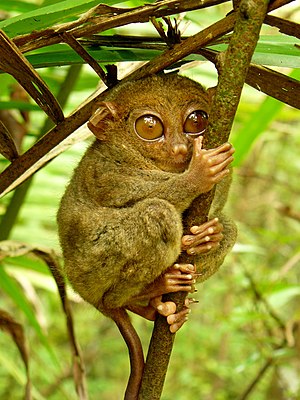Philippines tarsier
| Philippines tarsier | ||||||||||||
|---|---|---|---|---|---|---|---|---|---|---|---|---|

Philippines tarsier ( Carlito syrichta ) |
||||||||||||
| Systematics | ||||||||||||
|
||||||||||||
| Scientific name of the genus | ||||||||||||
| Carlito | ||||||||||||
| Groves & Shekelle , 2010 | ||||||||||||
| Scientific name of the species | ||||||||||||
| Carlito syrichta | ||||||||||||
| ( Linnaeus , 1758) |
The Philippine tarsier ( Carlito syrichta , Syn .: Tarsius syrichta ) is a primate species from the group of tarsier . In the Philippines he is known as the Philippine Tarsier, or just as the Tarsier .
features
Philippine tarsier are among the larger representatives of the tarsier. They reach a head trunk length of 12 to 13 centimeters, the tail is with 25 centimeters significantly longer than the trunk. Their weight is 110 to 150 grams, with the males being slightly heavier. Their fur is dense and short, it is gray-brown in color. The round head sits on a very short neck, as with all tarsier the eyes are greatly enlarged. To adapt to jumping locomotion, the hind legs are greatly enlarged and the tarsus lengthened. The fingers and toes are also elongated and end in rounded finger pads. The long tail is largely hairless, as is the tarsus, which distinguishes this species from other tarsier.
Philippine tarsiers communicate with each other via ultrasound with a dominant frequency of 70 kHz, presumably in order not to be noticed by their enemies. The upper hearing threshold is 91 kHz.
distribution and habitat
Philippine lemurs are found only in the southeastern Philippines . Their distribution area includes the islands of Samar , Leyte , Bohol and Mindanao as well as smaller, offshore islands. Their habitat are mainly rainforests. They are relatively adaptable and can also live in secondary forests , but in primary forests they have larger populations.
Lifestyle and diet
Philippine lemurs are nocturnal and usually stay in the trees. They spend the day sleeping in dense vegetation. When looking for food they move vertically climbing and jumping, they rarely walk on all fours. Usually they are in the low tree regions.
They are territorial animals that inhabit areas of one to two hectares. These areas are marked with urine and glandular secretions. The reports on their social behavior are contradicting. In addition to individually living animals, there are also small groups, but they probably do not live in monogamous family groups like the Koboldmakis from Sulawesi. They communicate with a series of screams and sounds, which, among other things, serve to mark the territory or to establish contact with conspecifics.
Like all tarsiers, Philippines tarsiers are carnivores. They primarily eat insects , but also spiders and small vertebrates such as lizards and birds .
In human care, the animals can live to be over 13 years old.
Reproduction
These animals have a monogamous reproductive system. Mating can take place all year round; after a gestation period of around six months, the female gives birth to a single young. At 25 grams, this is very large and well developed. It is weaned at around 80 days.
Danger
The main threats to the Philippine tarsier include hunting and habitat destruction. The animals are hunted because their meat is eaten or because they are made into pets . Due to their adaptability, however, they are less threatened than other Filipino mammals, the IUCN lists the species as " near threatened ".
The species is no longer kept in Europe, former owners are Frankfurt, Stockholm and Bristol.
literature
- Thomas Geissmann : Comparative Primatology. Springer-Verlag, Berlin et al. 2002, ISBN 3-540-43645-6 .
- Colin Groves, Myron Shekelle: The Genera and Species of Tarsiidae. International Journal of Primatology, December 2010, Volume 31, Issue 6, Pages 1071-1082, DOI: 10.1007 / s10764-010-9443-1
- Ronald M. Nowak: Walker's Mammals of the World. 6th edition. Johns Hopkins University Press, Baltimore MD 1999, ISBN 0-8018-5789-9 .
Web links
- KJ Gron: Primate Factsheets: Tarsier ( Tarsius )
- Information at Animal Diversity Web
- Information at theprimata.com
- Tarsius syrichta in the endangered Red List species the IUCN 2008. Posted by: I. Arboleda, 2008. Accessed on 22 second in 2009.
Individual evidence
- ↑ Groves & Shekelle (2010), page 1,077th
- ↑ Marissa A. Ramsier, Andrew J. Cunningham, Gillian L. Moritz, James J. Finneran, Cathy V. Williams, Perry S. Ong, Sharon L. Gursky-Doyen, Nathaniel J. Dominy: Primate communication in the pure ultrasound . In: biology letters . Vol. 8, No. 4 , 2012, p. 508-511 , doi : 10.1098 / rsbl.2011.1149 .
- ↑ [1] ZTL 18.6

